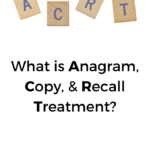How To:
Anagram, Copy, and Recall Treatment for Writing
6 min read
For those who have lost the ability to speak after a stroke, writing can offer another avenue for communication. However, aphasia often impacts both spoken and written language, so impaired writing (agraphia) requires specialized treatment to improve.
The Treatment
Anagram, Copy, and Recall Treatment (ACRT), a combination of Anagram and Copy Treatment (ACT) and Copy and Recall Therapy (CART), is an evidence-based lexical treatment for writing single words for people with severe aphasia and agraphia. This treatment requires lots of repetition, so motivation to improve and determination to practice are essential. While time-intensive, this practice can largely be done at home with simple tools and a helper, or independently with apps.

Choosing Words
Pick functional words when verbal expression isn’t effective for communicating basic needs in more severe aphasia. Family names, common requests, and recurring topics are good targets to train. Select a set of words (25-40) that the person with aphasia wants to practice. Get family or caregiver input on the list, then run them by the person with aphasia to make sure they approve.
For example: A 65 year-old man with aphasia may wish to write his name (Bob), his wife’s name (Cheryl), the names of his children (Dan and Karen), his grandchildren (Mackenzie and Noah), the town where he lives (Westfield), the places where his children live (Ohio and Florida), his favorite sport and team (football, Colts), his most requested items (iPad, Netflix, coffee, sandwich), his past career (engineer), and the issues he likes to talk about (fishing, election, movies, BMW). Now he can use those words to tell people about himself and his family, to let his wife know what he wants, and to bring up topics of conversation he enjoys.
Alternately, when verbal expression is recovering nicely, it may be written skills that need attention. In this case, make a list of simple or familiar words that start with each sound. Train this set of words using the method below. These words will become the keywords used in the next step of writing therapy, phonological treatment.
For example, “top” may be a good key word for the sound /t/. Once the person can reliably write “top” and words beginning with all the other sounds, they may be ready for sound-based treatment. In this more advanced therapy, they can learn to associate the letter T in “top” with the sound /t/ to begin sounding out words. Key words and the phonological treatment are part of our Advanced Writing Therapy app, the next step in agraphia treatment.
How To Do Anagram, Copy, and Recall Treatment
Once you have generated a word list, organize it with the shortest and most regularly spelled words first to ensure early success. Divide the words into sets of 5-10 to work on at a given time. After the first set has been mastered, move to the next set.
You’ll need pictures of the words, letter tiles (Scrabble® or Banangrams® tiles work well), paper, pencil or marker, and a helper. Or, you can independently use the Writing Therapy app with just pen and paper (see below).
Download this “How To” guide now.
Get your free PDF on how to do Anagram, Copy, & Recall Treatment with and without apps. Reference it during treatment, share it with students, or train families to work at home.

In addition to receiving your free download, you will also be added to our mailing list. You can unsubscribe at any time. Please make sure you read our Privacy Policy and Terms & Conditions.
ACRT Using the Writing Therapy App
Not everyone has a therapist or partner around to help with therapy. Even if there is someone nearby, you may be without the letter tiles or pictures you need to practice. Using the Writing Therapy app on your iOS or Android device, you can work independently or without extra supplies.
Pro Tip: If you want to practice only certain words, set Number of Trials to All on the Settings tab and touch Advanced Settings. Press Choose next to Customize Word List. Select only the words you want to practice. If using your own pictures and words, go to the Categories tab and press Add/Edit Custom to add a photo and sound. Select all categories on the Categories tab once you’ve edited your word list to ensure all your words will show up. You only need to set up your word list once.
Changing Difficulty
Remember: You don’t have to stick strictly to the protocol. There are lots of variations of anagramming, copying, recalling, and repeating that can work. The key ingredients seem to be intensive practice, focusing on just a handful of words at a time, and choosing words the person with aphasia is motivated to learn and use.
Setting Goals for Anagram, Copy, and Recall Treatment
Short-term goals for this therapy approach should focus on increasing the accuracy of writing the words from the treatment list. Start with writing in response to picture stimuli, then move up to writing to dictation, and finally, writing in response to questions designed to elicit the treated words.
Long-term functional goals may include communicating novel information or making requests via writing. If not observed during therapy sessions, this can be measured by family report from conversational interactions at home. The client may have specific goals related to writing notes, taking messages, making lists, or electronic correspondence.
Resources for Anagram, Copy, and Recall Treatment
Most of the research on ACRT has been led by Pélagie M. Beeson, Ph.D. and her lab at the University of Arizona. Many helpful protocols, references, and examples of writing assessments and treatments are freely available on the Aphasia Research Project website. Train keywords if you plan to advance to phonological therapy.
Keywords are incorporated into the Advanced Writing Therapy app, part of Advanced Language Therapy 4-in-1. Try Advanced Language Therapy Lite for FREE to sample all 4 apps to take speech therapy to the next level.
An entire chapter is dedicated to ACRT in the Manual of Aphasia and Aphasia Therapy – 3rd Edition. This valuable reference adds an extra step of anagramming with 2 extra letters and copying again three times after Step 3. There’s also a useful 6-point scoring system to help track progress.
There’s a detailed overview of ACT and CART treatment and the evidence for these approaches on the Communication Therapies for Adults blog.
A 2013 study looked at using one-handed typing on the keyboard on a mobile phone to practice sending text messages. T-CART is a modified protocol for texting, but could be used for any typing practice as so much of our modern communication is now digital.




















